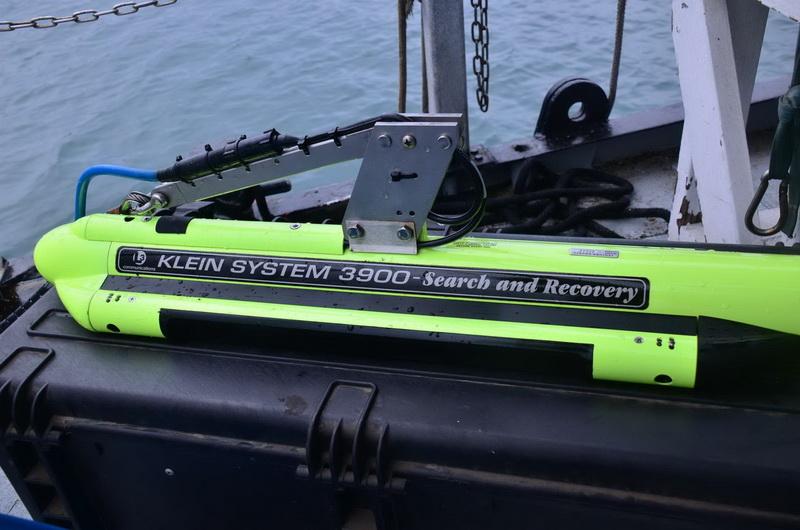By Founder and President Kurt Lieber

We've been doing that by putting our veteran volunteer divers in the water, and when they locate something having them attach a line to it so our topside volunteers can haul it up to the surface.
This is a very laborious process and we've been hoping to find people and/or technology with the means to help us locate debris without having to put divers in the water. That is where our new friends with the Ventura County Sheriff's Department Search and Rescue Team come in!
Alliance Building
This offers me a perfect time to talk about the "A" in ODA! It takes more than one person or group to take on a big project like cleaning the oceans, and we continue to grow our alliance of ocean defenders. In 2013, especially in Ventura and Santa Barbara Counties, we have successfully recruited and put-to-work a variety of sailors, teachers, marine engineers, marine architects, (off-duty) enforcement officers, and folks from numerous other businesses. We also have a growing number of students (who must be accompanied by a parent) interested in what we are doing; they are not allowed on ocean-going campaigns, but have proven invaluable during our in-harbor cleanups…and their energy is truly fabulous.

ODA has also developed a highly productive relationship with the Channel Islands Harbor Patrol and the Harbor Master's Office. This has allowed us the opportunity to spearhead a project to clean the harbor of deadly and toxic debris. On days when the weather creates unsafe surface conditions in the Channel Islands, we can sometimes conduct cleanup operations within the harbor, where shelter offers safer operating conditions for our volunteers. We have already conducted multiple dives in the harbor with the assistance of the wonderful Harbor Patrol staff, and removed huge piles of toxic batteries, electronics, and other gear dumped by careless boaters. This work has inspired the Harbor Masters to increase boat/debris monitoring, and discussion has begun to create an ongoing program to keep the harbor clean for ocean life. Harbors, though man-made, require proper stewardship because they provide important refuge for many forms of ocean life-especially juveniles-in an era where natural habitats are being diminished.
Sheriffs and Harbor Masters, and Teachers-OH MY!
Way back in September of last year I was invited by Dominique Evans, a high school teacher of marine sciences, to give a presentation to the students at Clark Magnet School. Dominique has a reputation as a great teacher and, with the aid of several grants she has been able to purchase a side scan sonar unit as well as a remote operated vehicle (ROV) to help her students learn about some of the issues that our local oceans are facing. Her plan is to have her students use these high-tech gadgets to gather information from the depths…and further, possibly in support of ODA's debris removal program!
Now…back to the cool technology!
I'd like to share a bit more information about the two new pieces of technological equipment we are using. The side-scan sonor and ROV work separately and give us different results, but used together they give us information that can enhance our ability to locate debris.


After trying for months to get all the people, gadgets, and a working boat in the same place at the same time, the stars aligned on Saturday, February 8th. It was a gorgeous, cloud-covered day, and even though it felt like rain was imminent, we had fine weather.
Dominique was the sole representative from her school, and we were accompanied by Larry Fuller, Dan Harasty, and Jim Traverson who are all volunteers with the VCSDSRT. They use this gear to help them locate things that fall in the oceans…things like cars, planes, and boats. Each one of them is a scuba diver and wants to help ODA out by using their expertise with this advanced equipment. Lucky us!
ODA volunteer (and licensed captain) Rex Levi skippered the boat while I observed how the information was relayed from the devices onto the computer screens, which were all set up on the rear deck of our vessel the Clearwater.
Since this was our first time working together with this technology, we were not intending to removing anything, just focusing on locating areas that looked like we should send divers down to investigate. This will make our dives safer, and allow us to maximize our bottom time and dive-tank air usage.
In all, we spent about four hours searching the areas underneath 16 slips between the Harbor Patrol office and the public boat ramp. The area is roughly 500 yards long. We also scanned another area of the harbor that accommodates smaller commercial fishing boats, about another 200 yards.
While Jim, Dan and Larry operated the side scan unit, Dominique operated the ROV and took pictures of anything she thought might be useful.
It was a lot of information to absorb, and we are currently studying the results. With our divers, we will return to hot spots to compare what we think is hazardous marine debris-and what actually IS hazardous marine debris. It may take a few trials to figure this out, but it seems promising!

We've already removed about 2,500 pounds of junk from just two slips, and we all can't wait to see how much more we pull up in the coming months. The amount of ocean life living in these areas far exceeds what I had expected; without a doubt: this is a very worthwhile project!
Stay tuned, and if you would like to be part of this effort please visit our volunteer page!
Check out the day's events in this photo gallery.
Just click on a picture to enlarge and start the slide show.




















